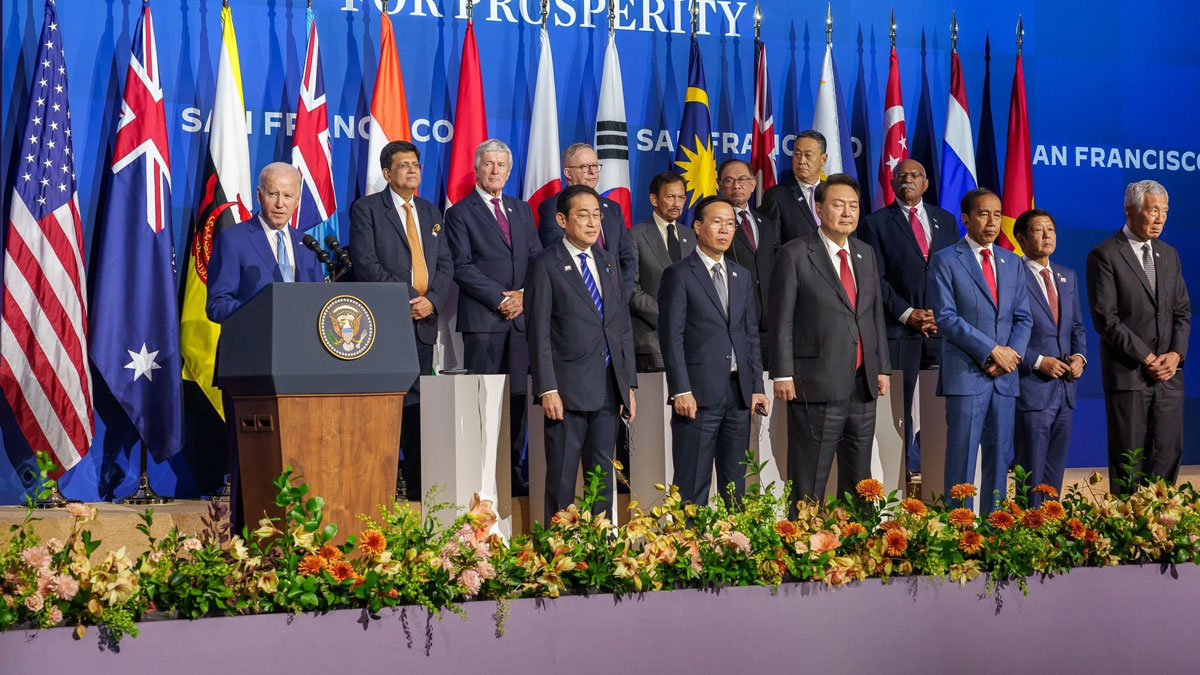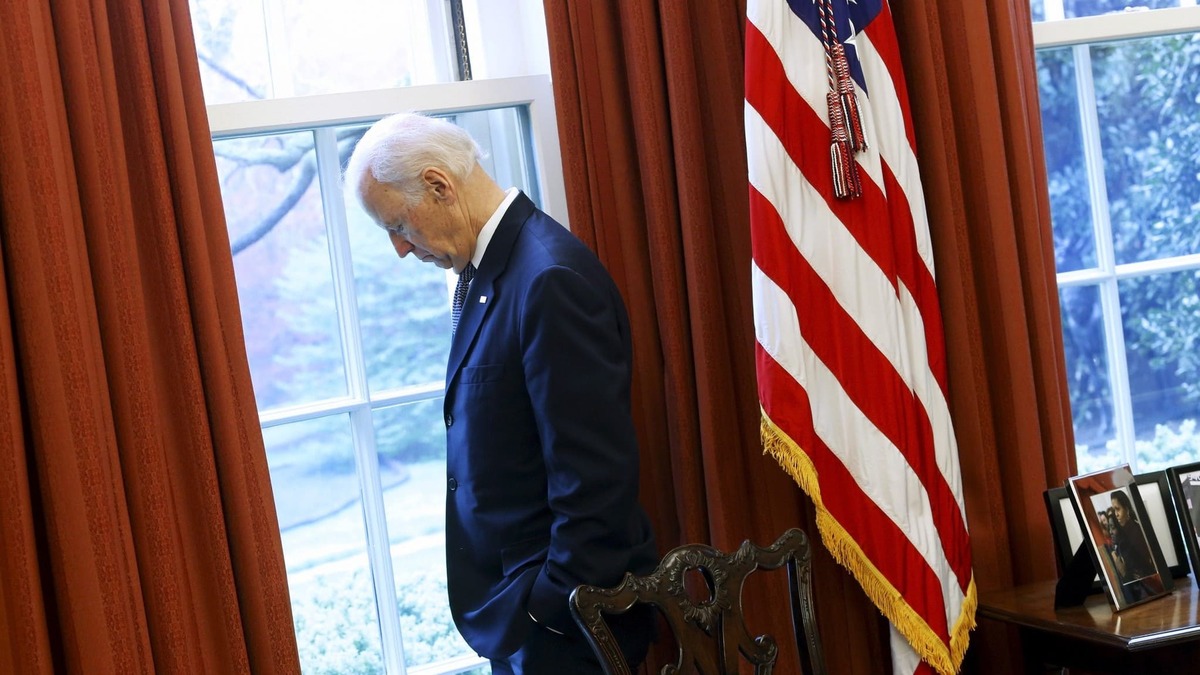Published 26 March 2024
As the US presidential election nears, no one in the world expects much progress on advancing global trade via IPEF in 2024. Nevertheless, many recognize the dire need for Washington to convince its allies and partners in the Indo-Pacific on American's intent on economic engagement with the region.
The Biden1 administration launched the Indo-Pacific Economic Framework for Prosperity2 in May 2022, promising its 13 partners high-standard commitments that would deepen US involvement in Asia-Pacific trade, supply chains, clean energy and graft-busting.
But on the most politically and economically important aspect of the framework, its trade pillar, Washington’s partners got a rude shock.
As the framework’s delegations, representing an arc of nations from India to Australia to Japan, disembarked from flights in San Francisco3 in November expecting closure and bold announcements, they learned instead that the United States had yanked back4 the negotiated text on trade.
In baseball parlance, the US team stepped up to the plate at last November’s Asia-Pacific Economic Cooperation meeting hoping to score some runs for its Indo-Pacific Strategy. Instead, Washington lost courage at the crucial moment and squared off for a bunt. For baseball and cricket fans, this means gently swatting away the ball instead of swinging for the fences. The resulting dribbling ground ball got the US (barely) to first base, with the group concluding a couple of novel but less ambitious and non-trade-related outcomes.
What happened to President Joe Biden’s pledge5 in May 2022 to use the framework to "engage comprehensively with our partners on a wide range of issues," including trade?
The short answer is politics.
Just before the APEC summit in San Francisco, Sen. Sherrod Brown 6 (D-Ohio) forcefully appealed7 to the White House to cancel the Indo-Pacific Economic Framework’s trade pillar. Brown must defend a highl vulnerable seat8 in a predominantly Republican state in November. Fearful of electoral backlash, Brown is steadfastly opposed to anything that remotely "promotes" trade. Biden, very aware that the Democratic Party holds only a one-vote majority9 in the Senate, acquiesced.
The political dilemma extends beyond Brown and the Senate. To secure a second term, Biden himself must win Michigan, Pennsylvania and Wisconsin, three swing states with strong labor movements and powerful anti-trade sentiment. This explains why, in San Francisco, Biden scuttled much of the framework and instead rolled out a new White House memorandum playing up labor rights.10
In this politically charged environment, virtually no one in the world expects much progress on trade via the Indo-Pacific Economic Framework in 2024.
Nevertheless, many recognize the dire need for the US to reach out to the Indo-Pacific, a keystone in the strategic and economic contest between the world’s two largest economies. To be effective in that contest, Washington must convince its allies and partners there of America’s intent on economic engagement.
The most obvious and effective strategy for Washington would be to return to the Trans-Pacific Partnership11 that the US designed and nurtured during the Bush and Obama administrations. That is what Japan would like Washington to do. But that appears politically impossible.
Instead, now far-sighted observers are looking toward two possible paths forward for the United States on trade policy — probably after this year’s upcoming election battle.
The first would be for Washington to reach agreements with its allies on critical emerging growth sectors.
Perhaps the biggest loss from last year’s setback was the abdication of US leadership on global digital trade policy. The framework’s initiative aimed for progress on digital policy but in October, even before APEC, the White House ditched12 long-held positions on cross-border data flows, data localization and source code transfers, undermining years of its contributions toward multilateral digital governance.
Now, parts of the Asian region are moving forward on these issues without the United States. Meeting in Singapore in late January, the Association of Southeast Asian Nations confirmed a plan13 to conclude an ASEAN Digital Economy Framework Agreement by 2025. Nation by nation, significant changes in regulatory environments throughout the Indo-Pacific region are taking rapid shape on internet governance, artificial intelligence, data privacy, data management, e-commerce and digital trade.
If the United States were to reengage under a sectoral approach, it would focus strategically on narrower trade policy areas with the greatest impact on America’s economic growth. This would imply going after narrower deals on artificial intelligence, advanced computational technology, new energy technologies and securing upstream minerals and materials that make these innovations possible.
The Indo-Pacific Economic Framework was designed to fit somewhere between the hard limitations of a binding trade agreement and the more consensual and collaborative deals like those in APEC. The US could adopt this approach to negotiations on critical emerging sectors, with a high probability of success.
A second, perhaps overlapping, alternative would be to reinvigorate binding bilateral trade agreement negotiations.
From the standpoint of crafting an optimal Indo-Pacific political strategy, it could make sense for Washington to concentrate on negotiating on a bilateral basis with some of its most important Indo-Pacific economic partners — and adversaries.
The best approach would be to launch full comprehensive free trade agreement negotiations with Japan and Taiwan while restarting Phase Two trade talks14 with China.
Much preparatory work has been done on such approaches over the past few years, including a first-round US-Japan Trade Agreement15 and ongoing work on a US-Taiwan Initiative on 21st Century Trade.16 Given the impracticality of decoupling the Chinese market from U.S. exporters, Washington must also return to trade talks with China. One could imagine a second Trump administration picking up where it left off in its high-stakes bilateral trade negotiations with China in 2019.
After what’s likely to be a bruising political year, it will be essential for Washington to get back to business in 2025 and show the level of global economic leadership it is still capable of achieving.
This article was first published on The Hill on March 9, 2024.
***
[1] https://thehill.com/people/joe-biden/
[2] https://ustr.gov/trade-agreements/agreements-under-negotiation/indo-pacific-economic-framework-prosperity-ipef
[3] https://www.whitehouse.gov/briefing-room/statements-releases/2023/11/16/fact-sheet-in-san-francisco-president-biden-and-13-partners-announce-key-outcomes-to-fuel-inclusive-sustainable-growth-as-part-of-the-indo-pacific-economic-framework-for-prosperity/
[4] https://www.reuters.com/world/asia-pacific/us-commerce-secretary-says-closed-three-pillars-indo-pacific-talks-2023-11-15/
[5] https://www.whitehouse.gov/briefing-room/statements-releases/2022/05/23/fact-sheet-in-asia-president-biden-and-a-dozen-indo-pacific-partners-launch-the-indo-pacific-economic-framework-for-prosperity/
[6] https://thehill.com/people/sherrod-brown/
[7] https://www.brown.senate.gov/newsroom/press/release/brown-successfully-pushes-biden-administration-to-remove-the-trade-pillar-from-the-indo-pacific-economic-framework
[8] https://thehill.com/homenews/campaign/4247899-sherrod-brown-ohio-2024-tough-reelection-poll
[9] https://www.senate.gov/history/partydiv.htm
[10] https://www.whitehouse.gov/briefing-room/presidential-actions/2023/11/16/memorandum-on-advancing-worker-empowerment-rights-and-high-labor-standards-globally/
[11] https://ustr.gov/tpp/overview-of-the-TPP
[12] https://www.whitehouse.gov/briefing-room/statements-releases/2022/10/07/fact-sheet-president-biden-signs-executive-order-to-implement-the-european-union-u-s-data-privacy-framework/
[13] https://ustr.gov/tpp/overview-of-the-TPP
[14] https://www.cnbc.com/2020/07/10/trump-says-us-china-relationship-damaged-phase-2-trade-deal-not-a-priority.html
[15] https://ustr.gov/countries-regions/japan-korea-apec/japan/us-japan-trade-agreement-negotiations/us-japan-trade-agreement-text
[16] https://ustr.gov/about-us/policy-offices/press-office/press-releases/2023/august/united-states-and-taiwan-hold-second-negotiating-round-us-taiwan-initiative-21st-century-trade-1
© The Hinrich Foundation. See our website Terms and conditions for our copyright and reprint policy. All statements of fact and the views, conclusions and recommendations expressed in this publication are the sole responsibility of the author(s).







